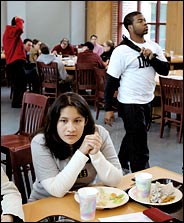

 |
| Michael Stravato for The New York Times |
| The Rice admissions panel considered applications on Friday. |
 |
| Michael Stravato for The New York Times |
| Vanessa Costilla, a Mexican-American freshman, said, "I got in because I earned it." |
 OUSTON, Dec. 6 — When a federal appeals court in New Orleans ruled in 1996 that the University of Texas Law School could not legally consider race in admitting students, lawyers at Rice University, a highly selective private college here, reluctantly decided that the ruling applied to it, too.
OUSTON, Dec. 6 — When a federal appeals court in New Orleans ruled in 1996 that the University of Texas Law School could not legally consider race in admitting students, lawyers at Rice University, a highly selective private college here, reluctantly decided that the ruling applied to it, too.
Almost overnight, the admissions officers at Rice stopped saying aloud the words "black," "African-American," "Latino," "Hispanic" or even "minority" in their deliberations. The next year, the proportion of black students admitted in the freshman class fell by half; the proportion of Hispanics fell by nearly a third.
The university feared that openly defying the federal court could cost it $45 million annually in federal aid, about 15 percent of its budget.
But like other colleges, Rice says it remains fiercely committed to having a diverse student body, so in the years since, it has developed creative, even sly ways to meet that goal and still obey the court. Thus the admissions committee, with an undisguised wink, has encouraged applicants to discuss "cultural traditions" in their essays, asked if they spoke English as a second language and taken note, albeit silently, of those identified as presidents of their black student associations.
Those efforts, along with stepped-up recruiting at high schools with traditionally high minority populations, yielded a freshman class last year with a near-record composition of blacks and Hispanics. Of the 700 freshmen, 7 percent are black, 11 percent Hispanic.
The experience of Rice provides a preview of the subtle ways that life would most likely change inside the admissions offices of colleges like Yale, Princeton and Stanford should the Supreme Court decide to impose strict restrictions on affirmative action. Those restrictions could be issued next year, when, the court said this week, it intends to consider two cases challenging racial preferences in admissions at the University of Michigan.
At issue is the court's 1978 Bakke decision, which has been widely interpreted as permitting public and private colleges to consider an applicant's race a "plus" in assembling a class.
Public universities — including those in Texas, Florida and California — have responded to lower-court decisions and other efforts to roll back Bakke by automatically accepting a set percentage of students ranked at the top of each public high school in their states. Because some of those high schools have heavy minority populations, a minority presence in the university system is assured.
But private colleges like Rice have long shunned such formulas as too mechanical and impersonal and have instead adopted a more nuanced approach that colleges elsewhere see as a blueprint, should they face a prohibition like that imposed by the Fifth Circuit Court of Appeals, whose jurisdiction is Texas, Mississippi and Louisiana.
"You can no longer say to the committee, `This is a great African-American from New York,' " said Julie M. Browning, the dean for undergraduate enrollment at Rice. "You have to drop a lot of language associated with affirmative action."
Instead, Ms. Browning said, the admissions team at Rice has developed a whole new vocabulary — including the overarching goal of achieving "cultural inclusiveness" in the student body — to justify its admissions decisions.
That new lexicon was evident this morning as the seven-member admissions committee met under a vaulted stucco ceiling here to winnow the list of nearly 500 students who have applied for early admission to the Class of 2007.
One of the first candidates under consideration had an obviously Hispanic last name, but no one on the committee mentioned it. Though other colleges affix color-coded stickers to the folders of minority applicants, Rice blots out students' answers to questions on their application about race or ethnicity. (Office assistants who are sworn to secrecy first record the answers for later use to make a statistical profile of applicants.)
While there were obvious clues that this applicant was Hispanic — a recommendation from a teacher noted his "desire to represent his Hispanic heritage" — the members of the committee found other ways to support his case, including his good grades in hard courses.
"He is first-generation college," said Jamila Mensa, the admissions officer charged with making the presentation. "The teacher described him as altruistic."
Another committee member, noting problems in the student's family, used admissions' shorthand to describe the candidate as "an overcome," and later said, "I just like the `overcome' here."
In the committee's opinion, these qualities helped the student rise above an SAT score more than 150 points below the 1400-point median at Rice in recent years. After just a few minutes of discussion, he was unanimously admitted.
For opponents of affirmative action, who have long argued that colleges have different standards for white and nonwhite applicants, the vote on this student would have provided little comfort. In response to a reporter's question, university officials refused to release statistics that they have gathered comparing the SAT scores of minority applicants accepted to Rice to those of nonminority applicants. They said only that the scores of minorities are generally lower nationally, and in the Rice pool as well.
Partly by engaging in delicate minuets like those danced by the committee this morning, Rice has faced no legal challenges in the six years since the lower court ruled in the case known as Hopwood v. Texas.
"You can't be using race or ethnicity as a factor in admission," said Richard Zansitis, the university's general counsel, in explaining the ground rules of Hopwood, which could serve the Supreme Court as a blueprint. "On the other hand, if a student has shown leadership — it may be in the black students association, it could be the chess club — that's something to look for in assessing that student as an individual. Whether it's leadership in an ethnic or racial organization is irrelevant."
The timing of the Hopwood decision was especially inopportune for Rice, which generally receives about 7,000 applications for a freshman class of about 700. Founded by a wealthy cotton trader in the early 1900's as an exclusively white institution, the university went to court in 1965 to change its charter so that minority students would be welcome to study on its campus of gingerbread buildings.
By 1996, the proportion of blacks (7.7 percent) and Hispanics (11 percent) in the freshman class was among the highest of any top college in the nation. Six years later, the Class of 2006, which arrived on campus this fall, was 7.1 percent black and 11 percent Hispanic. The percentage of Asian-Americans was 16 percent.
Over that period, the university increased its canvassing of high schools with many minority students — including Eleanor Roosevelt in Greenbelt, Md., and Central High School in Philadelphia — and tripled its budget for flying minority students to campus for recruiting visits, which Hopwood permits. (None of the voting members of the committee are permitted to meet those recruits.)
Some minority students at Rice said that the university's abandonment of affirmative action, at least in its classical definition, has made them feel an enhanced sense of pride at getting in.
Vanessa Costilla, 18, a freshman from Anton, Tex., who is Mexican-American, said her admission to Rice probably meant more than her admission to two Northeastern colleges, Smith and Wellesley, which still give a lift to minority applicants.
"I don't think that just because I was Hispanic-American I got into Rice," said Ms. Costilla, the valedictorian of her 25-member high school class and president of "everything except the Future Farmers of America."
"I got in," she added, "because I earned it."
But Kristin Dukes, 19, a sophomore from Greenville, Tex., who is black, said that many of her classmates were unaware of the university's admissions policies.
"At Rice, probably in the back of their minds, kids are still thinking I was privileged to get in because of the color of my skin," said Ms. Dukes, a psychology major. "Just because they have new standards at the university doesn't mean the students at the university feel the same way."